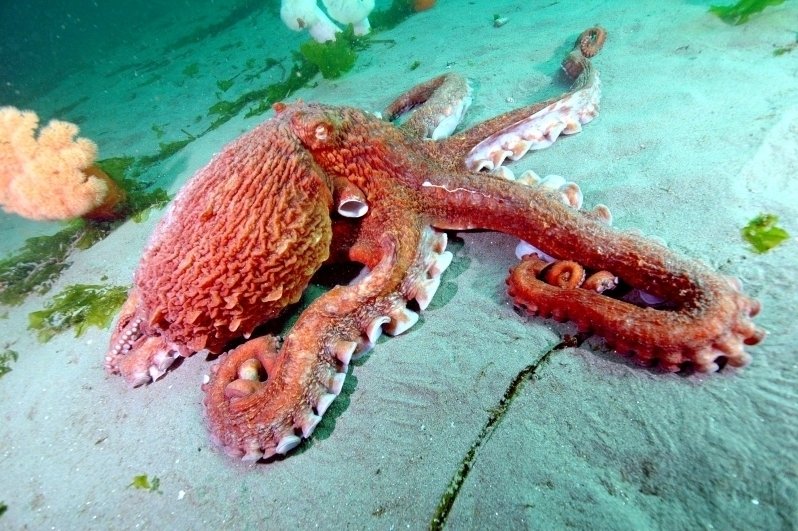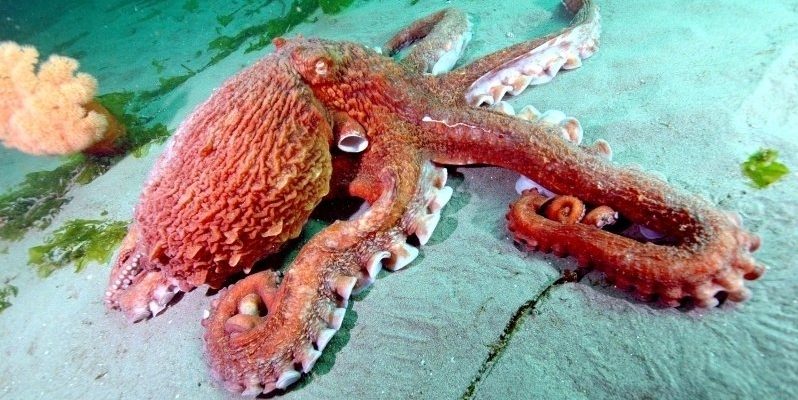
Imagine wandering through a mysterious underwater labyrinth, filled with rocky crevices and stunning marine life. That’s pretty much where you’ll find the Giant Pacific octopus. These remarkable creatures inhabit the chilly waters of the North Pacific, showcasing their incredible adaptability and intelligence. But there’s more to their habitat than just ocean depths—let’s explore the varied environments these clever cephalopods thrive in.
Understanding Their Distribution: Where Do They Live?
Giant Pacific octopuses are primarily found in the colder waters of the North Pacific Ocean. Their range stretches from the coast of Alaska down to California. However, they tend to stick close to the coast, preferring rocky shorelines and kelp forests. You might wonder why they choose these areas. Well, the rocky substrate offers plenty of hiding spots and places for hunting.
These octopuses are usually found at depths of up to 500 feet, but they can also be spotted shallower in tidal pools. They are excellent at camouflaging themselves against rocks and reefs, making it easier for them to catch prey while avoiding predators. Their ability to blend into their surroundings is nothing short of amazing and a key reason they thrive in these environments.
The Role of Temperature in Their Habitat
Temperature plays a significant role in where Giant Pacific octopuses can live. They prefer cooler waters, typically between 46°F and 55°F (8°C to 13°C). Warmer waters can make them lethargic, reducing their activity levels and hunting efficiency. This is why you won’t find them in tropical seas.
Here’s the thing: temperature not only affects their behavior but also their growth and reproduction. Colder waters help them develop more slowly but can lead to longer lifespans. In fact, some Giant Pacific octopuses can live up to 3 to 5 years in these cool, nutrient-rich environments, giving them plenty of time to hunt and thrive.
Exploring Their Preferred Habitats
Giant Pacific octopuses have a knack for finding unique habitats within their range. They often settle in rocky outcrops, tide pools, and underwater caves. These locations not only provide shelter but also offer a buffet of food options. Their diet includes crabs, clams, and even small fish.
The kelp forests along the Pacific coast are particularly rich environments for them. Think of a lush underwater garden where they can hide, hunt, and even socialize. Kelp provides plenty of cover and is home to various marine species, making it an ideal dining spot for these crafty creatures.
Another fascinating aspect is that they often create dens in these habitats, which are essentially their homes. They’ll move rocks around to create a cozy spot where they can rest and escape from predators. This behavior shows their intelligence and adaptability—traits that make them one of the more remarkable species in the ocean.
Your Encounter with a Giant Pacific Octopus
If you’ve ever thought about diving or snorkeling to see these octopuses in action, you’re not alone! Many passionate divers and marine enthusiasts venture out to find these creatures in their natural habitats. Popular spots include the Monterey Bay in California and the Sitka Sound in Alaska.
During dives, you might find yourself in awe as the Giant Pacific octopus gracefully moves through the water, showcasing its vibrant colors and impressive agility. Honestly, it’s like watching a ballet unfold in slow motion! Their curious nature often leads them to investigate divers, making for an unforgettable experience.
Remember, though, if you happen to encounter one, it’s important to keep your distance and respect their space. They may look enchanting, but they’re also wild animals with instincts to protect themselves.
What Threats Do They Face?
Despite being fascinating and resilient, Giant Pacific octopuses face several threats. One significant challenge is overfishing. Their natural predators, including sharks and larger fish, are also affected by fishing practices, leading to a delicate balance in the ecosystem.
Pollution is another pressing issue. Chemical runoff and plastic waste can destroy their habitats and harm their health. As ocean lovers, it’s crucial to raise awareness about these issues and support conservation efforts. Protecting the habitats of these incredible creatures ensures they continue to thrive for future generations to admire.
The Giant Pacific octopus is more than just a fascinating marine creature; it plays an essential role in its ecosystem. By understanding where they live, the habitats they prefer, and the threats they face, we can better appreciate their place in the ocean’s web of life.
Next time you think about the ocean, remember the cool, intelligent octopuses lurking beneath the waves. Whether it’s the rocky shores of the Pacific or the vibrant kelp forests, these areas are vital not only for the octopuses but for the entire marine ecosystem. So, let’s make it a point to protect these incredible habitats and the amazing creatures that live within them.

